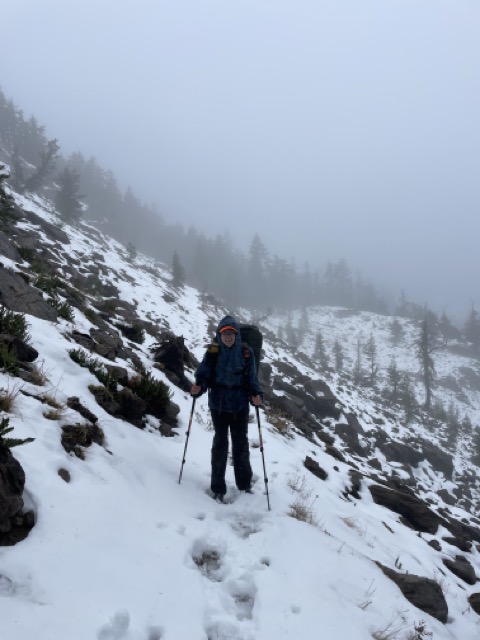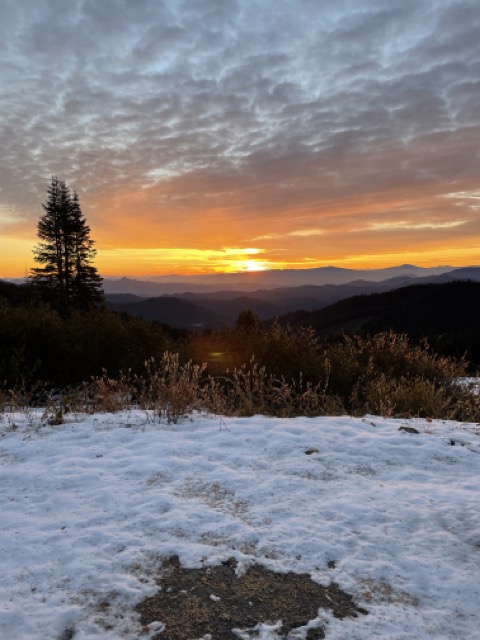Finishing at the Oregon Border: My Last 24 Hours on the PCT
My last 24 hours on trail were rough.
My friend Sol and I were trying to finish off a fire closure that had recently reopened. Flip-flopping all summer meant I had already finished all of Washington, all of California but a small sliver by the Oregon border, and nearly all of Oregon. All that was left was the stretch between Etna and Ashland that had been closed by a wildfire when I’d attempted hiking it over the summer. Finishing it off would mark the completion of my thru hike.
It was late October and a snowstorm had come through the area over the weekend. But I wasn’t worried. Sure, the snowstorm was intense further north, dumping tons of snow where I’d been hiking just a few days earlier. But in Ashland, it was only supposed to be a couple inches. No big deal.
Only we weren’t hiking in Ashland. We were in the mountains high above Ashland. As soon as we got out there, we realized how wrong our weather information was.
There were well over six inches of snow covering the ground, and the trail was a combination of ice, snow, frozen mud, and ice water. A mess of sleet, snow, and freezing rain accompanied us on our twenty mile hike after we headed south out of Callahans.
Even in the terrible conditions, Sol and I were in good spirits. Chatting, laughing, telling stories from the trail. Sure, we were both limping and the weather was hellish, we were freezing and our pathetic trail runners were soaked through with water to above the ankle. But we didn’t care. We were on an adventure.
Toward mid afternoon, Sol’s rain jacket failed completely. She was shivering and losing body temperature in the sleeting rain. As we set up camp at twilight, it was clear she was hypothermic. Luckily (or unluckily?) Sol had dealt with hypothermia during an ultramarathon she ran, and so she knew how to handle it.
I helped her pound stakes into the ground to get her tent set up, I gave her my spare lighter (in the worst timing ever, her lighter broke) and we talked through the tent walls as we heated water. I was particularly worried when she spilled much of her dinner due to hands made clumsy from the cold. But she did manage to eat and change clothes.
We went to bed, but I became increasingly concerned. It seemed really bad that Sol had been hypothermic. And I was worried about myself. Almost all of my gear was soaked. As night fell, that gear froze. I was having a hard time getting warm. We had the worst combination of weather: steady rain that soaked everything all day, cold enough that the snow didn’t melt, with enough wind to bring rain in under the edge of my ultralight tent and soak everything in the tent, and then a hard freeze over night.
We expected the weather to clear up in the morning, but there was a good chance that another bout of freezing rain would arrive by evening. I didn’t think I was in good condition to manage another night out unless I could at least find some way to dry my gear.
I’ve done a fair amount of winter camping and plenty of bad weather camping, but this was different. My gear was ultralight thru hiking gear, not winter backpacking gear. And while most of my gear could survive, I was very worried about my feet. Specifically, my toes. Walking for days in slushy cold snow and freezing water had left my feet numb and cold. Lying in bed with socks on my feet, they were still numb and cold. Sometime after midnight, my toes still freezing, I boiled water in my vestibule and put it in my Nalgene, then alternated the warm water bottle from foot to foot to try to bring life back into my cold toes.
Lying in my tent on my thin sleeping pad, shifting the Nalgene from foot to foot, I kept thinking to myself: I’m really going to need all of my toes after I finish hiking the PCT.
I take a lot of pride in handling my sh*t when I’m in the outdoors. I can imagine that there are situations where someone might need to call for emergency evacuation—for example, if you are mauled by a mountain lion or fall off a cliff or get bitten by a rattlesnake. Even in situations like that, I think it’s still best to try as hard as possible to hike yourself out of the wilderness.
But lots of people seem to use the Garmin emergency SOS button more like an uber—whenever they get scared or overwhelmed, they hit the button. And often, it’s because they made numerous foolish decisions that led to them being out in conditions when they shouldn’t have been.
I think this is unbelievably reckless and disrespectful. It uses up scarce emergency resources, can literally endanger the lives of emergency responders, and allows people to avoid taking responsibility for their own safety. Even when I’ve been in very bad situations (like when I hurt my ankle in Goat’s Rock and couldn’t put weight on it), I never considered using the emergency button.
As the temperature dropped and I lay in my tent, I could imagine it. Right then, at that moment, I was cold and wet but I wasn’t in danger.
But if I pushed on and the weather stayed bad, and I had another night where I wasn’t able to get my feet and gear dry? I’d be pushing into hypothermia and frostbite territory. I could imagine being one of those hikers who needs to push an emergency rescue button, and, if I made enough stupid decisions, it could even happen within twenty-four hours.
And there was no way I was going to do that. For one thing, my park ranger husband would never let me live it down.
I had less than 100 miles left to hike down to Etna. I deeply wanted to finish it off. It mattered more to me than pretty much anything.
Except, it turns out, finishing the Pacific Crest Trail with all ten toes.
I like to hike early in the morning and then stop for breakfast after a couple hours of hiking. The plan had been for me to wake early and hike four or five miles, then eat breakfast and wait for Sol to catch up.
But I was awake at 4 AM, too cold and worried to sleep, my shoes frozen solid, and I knew that I shouldn’t keep going. I wasn’t going to knowingly hike myself into danger, risk having to call emergency services or risk hypothermia or frostbite. As much as I wasn’t ready for it to happen, my thru hike was over.
I waited for Sol to wake up and told her that she could keep going if she wanted to, but I needed to turn back. My ultralight hiking gear wasn’t up to these winter conditions. I cried a bit, and I told her I was sorry to let her down.
Talking through the tent walls in the frozen dark, Sol said she didn’t want to turn back. She acknowledged that things were bad, and would be especially bad if we couldn’t get our gear dry somehow today. But turning back before the Oregon border was pretty unthinkable to her. She argued that we should make it to the Oregon border and then take a series of dirt roads down off the mountain to Seiad Valley. I agreed.
I texted my partner and asked him to come meet me in Seiad Valley. It was a few days early and 90 miles short of where I’d planned to meet him for the end of my trail, but he agreed to come.
Packing up was ridiculously slow. Everything was frozen. Trying to wedge my cold feet into literally frozen shoes took more than 30 minutes because I couldn’t get the shoe open enough to fit my foot in. I wondered aloud if it would be better to boil water and pour it on the shoe to try to loosen it up, and then watched as Sol asked the same question when she was trying to wedge her shoes on after me. I couldn’t tie my shoe laces at all because they were frozen solid, so they just protruded out of my shoes like weird misshapen frozen tentacles. We eventually managed to pack away the rest of our gear, scraping ice off the tents and stuffing frozen clothing into frozen packs.
And then as soon as we started walking—edging through the snow with shoes untied, Sol wearing a garbage bag for warmth, my hands shoved into ziplock baggies because my gloves were frozen solid—my hiking pole caught on a frozen tree branch and yanked my hand back. I noticed the pain but there wasn’t anything I could do about it. I’d find out later that I’d badly sprained my wrist and it would take weeks for it to heal. (One of a few reasons it’s taken me so long to publish this blog post.)
Around 10 AM, my shoes finally thawed enough that I could tie my laces, though that proved a special challenge with my newly sprained wrist.
We descended quite a bit out of the snow and eventually hit the California border. It was nice to have finally reached the California/Oregon border, something I’d been trying to get to for months. A couple miles later, we hit a dirt road and turned off the PCT to begin the long descent into Seiad Valley. The sun came out and some of our gear started to thaw after lunch.
I reminded myself that I’ve been so much luckier than many other thru hikers this year. I was able to complete all of Washington and touch both the southern terminus and the northern terminus, something I’d dreamed of doing. I got to hike all of Oregon, which was a miracle when a lot of other hikers skipped hundreds of Oregon miles or went out and hiked the Oregon Coast Trail instead. I even got to hike through the 150 miles Lionshead Fire Closure, which almost all the hikers ahead of me missed. So I was luckier than many.
But I also felt grief and disappointment. I wanted my hike to end in Etna, where I’d first been pushed off trail by wild fire and skipped ahead to begin my flip-flop. I like to do things exactly by the book, and I like to do them completely. I hated that I couldn’t finish that final 93 miles. But I also didn’t have the gear for these conditions, and didn’t have an accessible way to upgrade my ultralight tent and shoes to serious winter gear.
So I ended my hike in Seiad Valley, proud and sad all at once, with a sprained wrist and all ten toes.
This website contains affiliate links, which means The Trek may receive a percentage of any product or service you purchase using the links in the articles or advertisements. The buyer pays the same price as they would otherwise, and your purchase helps to support The Trek's ongoing goal to serve you quality backpacking advice and information. Thanks for your support!
To learn more, please visit the About This Site page.





